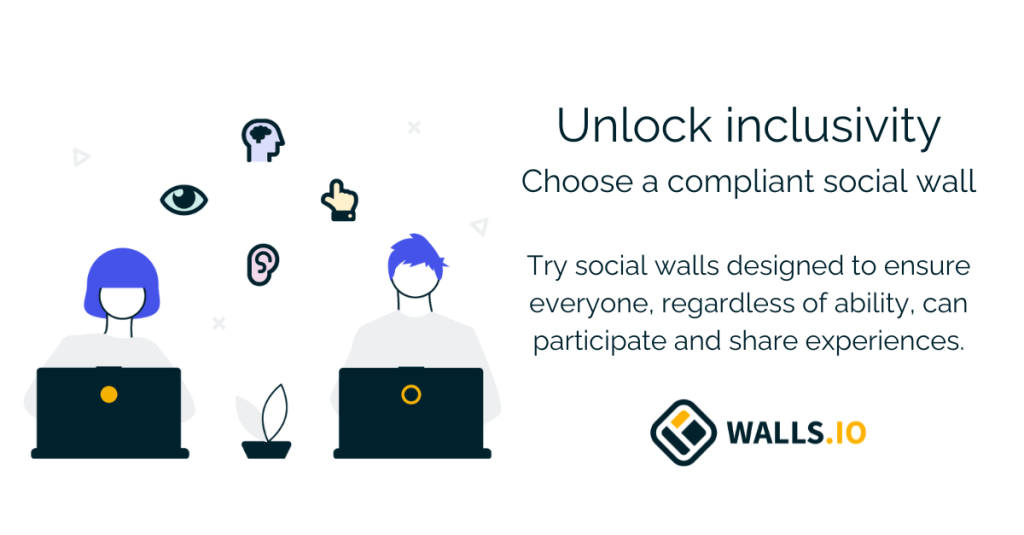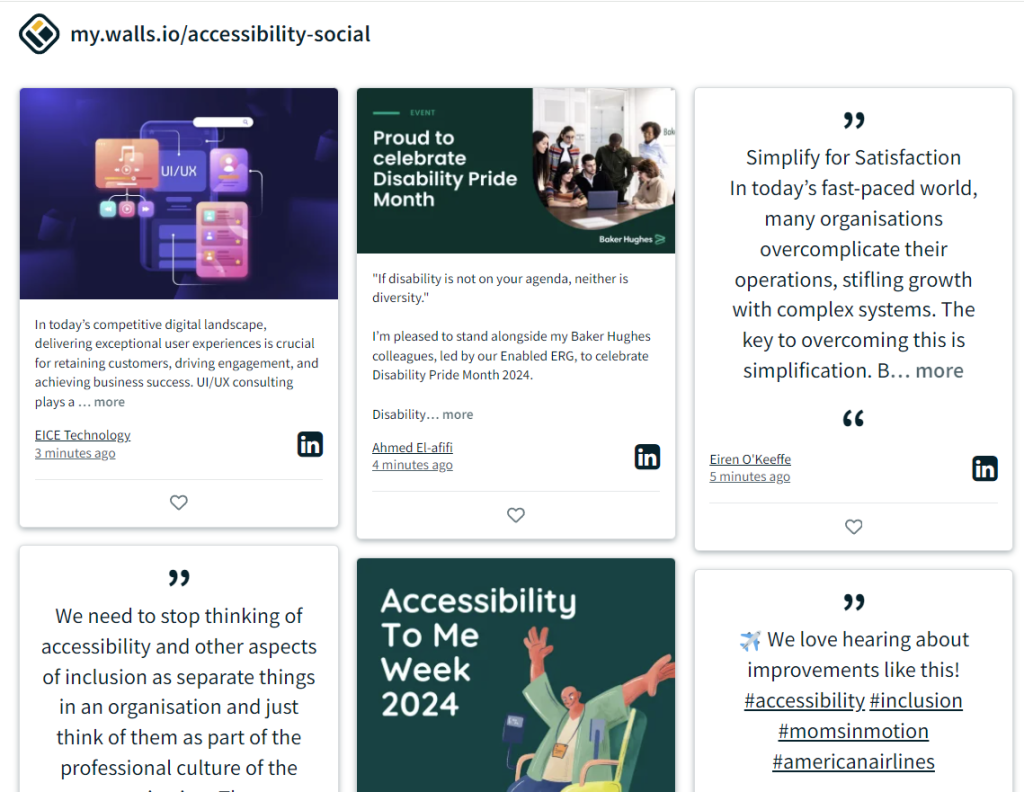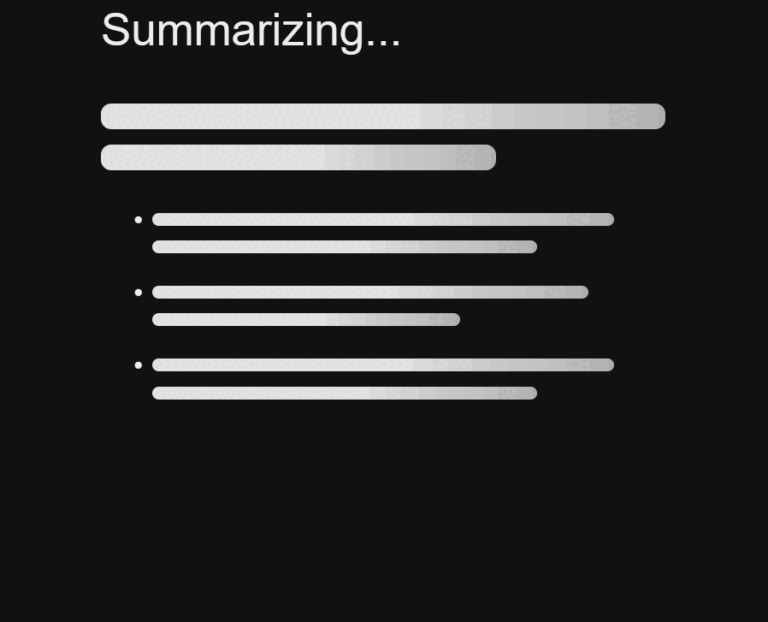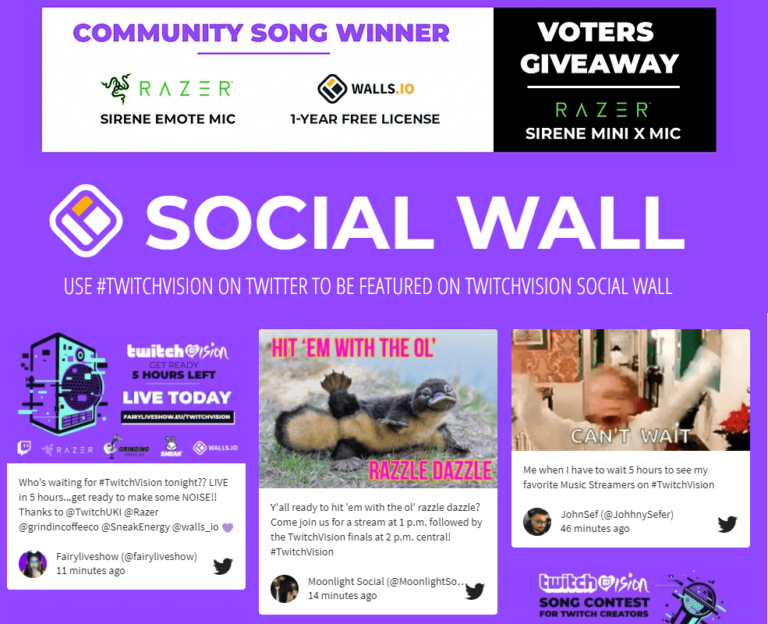Social media accessibility is essential for including everyone in communication and engagement on these platforms. This article examines the laws in the USA and EU that require social media accessibility. We will explore when these rules were enacted, who must comply, and how to meet these requirements, focusing on accessible social media tools like Walls.io.
Social media accessibility means making social media content and platforms usable and inclusive for everyone. This means making sure people with different disabilities can use social media. Here are the main points:
- Visual accessibility: This includes alt text for images, high-contrast text and backgrounds, and text resizing. Screen readers read alt text, helping visually impaired users understand images.
- Access for people who are deaf or hard of hearing: Captions and transcripts for audio and video help people who are deaf or hard of hearing access the information.
- Motor accessibility: Designing platforms and content that can be navigated with a keyboard or other assistive devices is essential for users with limited motor skills.
- Cognitive accessibility: Simpler language, more straightforward navigation, and simpler interfaces help users with cognitive impairments.
- Meeting standards: Following accessibility guidelines like WCAG ensures that social media and content are accessible.
- Inclusivity: Allows everyone to participate in social media.
- Legal compliance: Helps organizations comply with legal requirements.
- Better user experience: Makes content easier to access and understand.
- Broader reach: Expands the audience.

Understanding the Americans with Disabilities Act (ADA)
The Americans with Disabilities Act (ADA) is a civil rights law that prevents discrimination against people with disabilities. Title III of the ADA requires that public accommodations, including websites and web applications, be accessible to people with disabilities. This includes social media platforms and tools for managing and displaying content.
Although the ADA was enacted in 1990, its application to digital spaces, including social media, has been reinforced through various legal cases in recent years. Notably, the 2019 case Robles v. Domino’s Pizza, LLC underscored that websites and mobile apps must be accessible under the ADA. This ruling set a precedent, clarifying that social media platforms and related applications must comply with ADA requirements.
The ADA applies to a wide range of organizations, including:
- Private businesses that provide goods or services to the public, such as companies managing social media platforms.
- Nonprofit organizations use social media for outreach and engagement.
- State and local governments utilize social media for communication and public services.
- Use accessible social media tools: Choose tools like Walls.io to aggregate and display social media content. Walls.io offers layouts and features that comply with WCAG guidelines, making your content accessible to all users.
- Alt text for images: Include descriptive alt text in social media posts to support screen readers and visually impaired users.
- Video captioning: Ensure all your social media videos are captioned. Captions help users who are deaf or hard of hearing and also make your content more accessible in sound-off environments.
- Keyboard navigation: Verify that users can navigate your social media platforms and any tools you use with a keyboard. This is essential for users with mobility impairments.
- Accessible links: Use clear and descriptive link text that tells users exactly where the link will take them or its purpose.
- Test with assistive technologies: Regularly test your social media content with screen readers and other assistive technologies to ensure it works well for all users.
The EU Web Accessibility Directive (EU) 2016/2102 requires that public sector websites, mobile apps, and social media channels be accessible to all users.
The directive targets public sector entities, including:
- Central and local government websites and their social media channels.
- Publicly funded educational institutions’ websites and social media.
- Publicly funded healthcare providers’ websites and social media.
Tips for compliance with the EU Web Accessibility Directive
- Implement WCAG standards: Ensure your social media tools and content adhere to WCAG 2.1 AA standards for accessibility.
- Accessibility statements: Publish an accessibility statement on your social media profiles, explaining your compliance efforts and available support options.
- User feedback mechanism: Provide a way for users to report accessibility issues directly on your social media platforms.
- Regular audits: Regularly audit your social media content and tools to identify and address accessibility issues.
- Staff training: Train your staff on creating accessible social media content and using tools like Walls.io that support accessibility.
- Accessible forms and links: Make sure any forms and links shared on your social media are accessible and clearly labeled.
The European Accessibility Act (EAA) aims to standardize accessibility across the EU and covers a variety of products and services, including digital and social media tools.
- Adopted: June 7, 2019
- Transposed into National Law: By June 28, 2022
- Requirements Effective: From June 28, 2025
The EAA applies to a wide range of products and services, including:
- Computers and operating systems
- ATMs, ticketing, and check-in machines
- Telecommunication services and digital content, including social media tools
- E-commerce services and digital platforms, including social media
Tips for compliance with the EAA
- Understand the requirements: Familiarize yourself with the specific accessibility standards for social media tools and platforms, as outlined in the EAA.
- Use accessible platforms: Choose platforms like Walls.io that already meet these accessibility standards.
- User testing: Involve disabled users in testing your social media tools and content to find and fix practical barriers.
- Accessible customer support: Ensure your customer support on social media is accessible, including responding in formats that all users can access.
- Documentation and training: Keep detailed records of your accessibility efforts and train your staff on creating accessible social media content.
Walls.io is an excellent example of a tool prioritizing accessibility. Here’s why:
- WCAG compliance: It meets the Web Content Accessibility Guidelines (WCAG) 2.1, ensuring content is accessible to perceive, operate, understand, and robust.
- Accessible layouts: Its layouts are designed to be easily navigable for individuals with disabilities.
- VPAT: Walls.io provides a Voluntary Product Accessibility Template (VPAT) that explains how it conforms to accessibility standards, helping organizations understand its compliance.

Accessible social feed widgets: Use Walls.io’s widgets to display social media content in an accessible format on your websites and displays. You can create and try the social media widgets for free.
⭐Related: Social Media Feed on Website Examples
⭐Related: Creative Social Media Display Ideas for Your Brand

Customization: Utilize its customization options to ensure your content meets accessibility standards.
⭐Related: How to Create a Branded and Accessible Social Media Feed
Conclusion
Making social media accessible is about creating an inclusive digital environment where everyone can participate. Organizations must comply with the ADA, EU Web Accessibility Directive, and the European Accessibility Act to ensure their social media platforms and content are accessible to all users.





